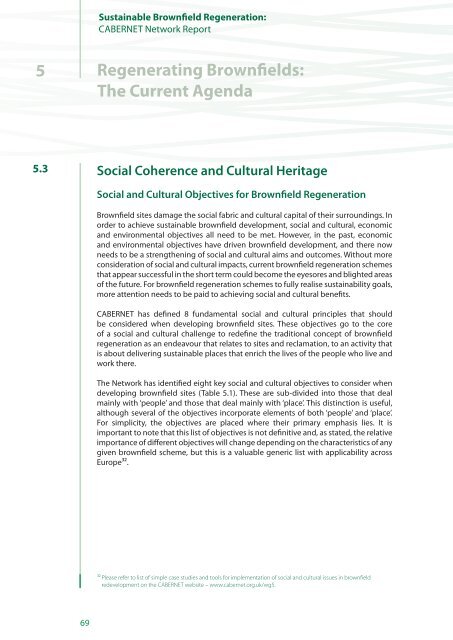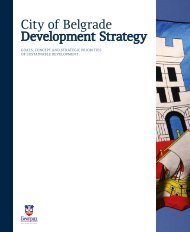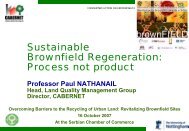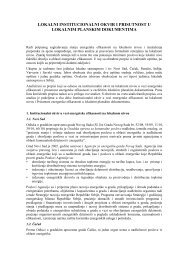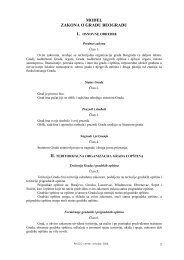Sustainable Brownfield Regeneration: CABERNET Network Report
Sustainable Brownfield Regeneration: CABERNET Network Report
Sustainable Brownfield Regeneration: CABERNET Network Report
You also want an ePaper? Increase the reach of your titles
YUMPU automatically turns print PDFs into web optimized ePapers that Google loves.
<strong>Sustainable</strong> <strong>Brownfield</strong> <strong>Regeneration</strong>:<strong>CABERNET</strong> <strong>Network</strong> <strong>Report</strong>5Regenerating <strong>Brownfield</strong>s:The Current Agenda5.3 Social Coherence and Cultural HeritageSocial and Cultural Objectives for <strong>Brownfield</strong> <strong>Regeneration</strong><strong>Brownfield</strong> sites damage the social fabric and cultural capital of their surroundings. Inorder to achieve sustainable brownfield development, social and cultural, economicand environmental objectives all need to be met. However, in the past, economicand environmental objectives have driven brownfield development, and there nowneeds to be a strengthening of social and cultural aims and outcomes. Without moreconsideration of social and cultural impacts, current brownfield regeneration schemesthat appear successful in the short term could become the eyesores and blighted areasof the future. For brownfield regeneration schemes to fully realise sustainability goals,more attention needs to be paid to achieving social and cultural benefits.<strong>CABERNET</strong> has defined 8 fundamental social and cultural principles that shouldbe considered when developing brownfield sites. These objectives go to the coreof a social and cultural challenge to redefine the traditional concept of brownfieldregeneration as an endeavour that relates to sites and reclamation, to an activity thatis about delivering sustainable places that enrich the lives of the people who live andwork there.The <strong>Network</strong> has identified eight key social and cultural objectives to consider whendeveloping brownfield sites (Table 5.1). These are sub-divided into those that dealmainly with ‘people’ and those that deal mainly with ‘place’. This distinction is useful,although several of the objectives incorporate elements of both ‘people’ and ‘place’.For simplicity, the objectives are placed where their primary emphasis lies. It isimportant to note that this list of objectives is not definitive and, as stated, the relativeimportance of different objectives will change depending on the characteristics of anygiven brownfield scheme, but this is a valuable generic list with applicability acrossEurope³².³² Please refer to list of simple case studies and tools for implementation of social and cultural issues in brownfieldredevelopment on the <strong>CABERNET</strong> website – www.cabernet.org.uk/wg5.69


